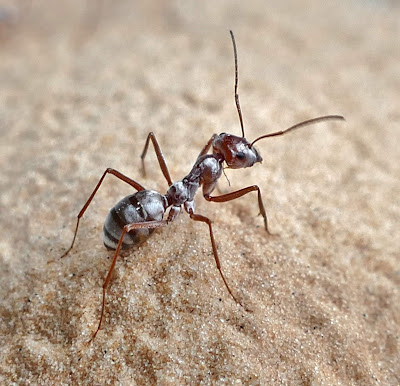Sunflower (Helianthus annuus) ~ Anticipating God in the Unknown
Odds are, you have a rhythm to your life. These rhythms might be daily, such as how you wind down after your workday, or even yearly, such as a summer holiday or family reunion. Most plant species have rhythms too, and not just the seasonal rhythms we know so well. Every plant has a distinctive daily rhythm, and many of these secret workings are still unknown to us. One of the most fascinating plant rhythms is its ability to move throughout the day in anticipation of its changing environment. Plants dance. They move and sway, bend and grope, reach and recoil. Plants move constantly, though it’s usually too slow for us fast-paced humans to notice. Like us, plants are regulated by hormones. These hormones, such as gibberellins and auxins, affect the growth and well-being of the plant. They also help the plant to react to stimuli, such as danger from bugs, obstacles, or water deep underground. As you can imagine, the most important stimulus for a plant to move toward is its food source: light. Plants often move throughout the day to face oncoming light, a phenomenon called phototropism (in Greek, photo=light & tropos=turning). Phototropism was first described by Charles Darwin, though he called it ‘circumnutation’ which, let’s be honest, is way more fun to say [1]. The plant most well-known for phototropism is the aptly named Heli-anthus, the sun-flower. Sunflowers exhibit a particular type of phototropism called heliotropism (helio=sun & tropos=turning) in which their heads move to follow the sun across the sky throughout the day. Scientists sometimes call this ‘solar tracking’. Cotton, alfalfa, and beans are all excellent ‘heliotropers’. Perhaps you have noticed a young green been in your garden changing the position of its tendrils as the sun moves. But sunflowers are a bit of an oddity because they lack the hardware usually needed for such dynamic movements. Sunflowers have no pulvini. Pulvini are the specialized motor organs that mediate solar tracking. Ever noticed that little bump at the base of a leaf stalk on most house plants? That’s the pulvinus, and it can turn the leaf any way it needs to go. Sunflowers lack these completely.
How can sunflowers move so much throughout the day without the use of pulvini? The secret is found in the stem. One side of the sunflower stem shortens and the other elongates, thus pivoting the head of the plant. In the morning, the sun-facing stem is shortened, and in the evening it elongates, and vice versa for the other side. It’s a bit like a pulley system hidden deep inside the plant.
But what I find most charming about the sunflower is not its ability to track the sun during the day, but its anticipation of the sun’s return during nighttime. After the light has fallen, the sunflowers turn their faces back towards the eastern horizon in anticipation of the dawn. This is called Anticipatory Eastward Movement and so far in my reading I haven’t been able to find an example of it anywhere else (if you find one, please add it into the comments section). One study tried to figure out how sunflowers do this. They took potted sunflowers and moved them into a growth chamber with fixed overhead lighting. Even after days of being indoors, the plants still moved their heads to face east overnight. This shows that the plants have their own circadian rhythm, and it’s an exciting find [2].
Sunflowers anticipate dawn. In the darkness of night, they move their heads east and await the light. This is a sweet lesson for me in this season. I’m facing many unknowns; perhaps you are too. I realize that I am ‘in the dark’ about a great many things; I don’t know what will happen next in my career or in my housing situation. But I want to be the sort of believer who can stand firm in the darkness and turn her face to the east as she waits for God to shine His light again. I want to turn my face to the Lord in prayer, turn my heart to Him in love, regardless of how distant He may feel. My heart posture indicates what I believe about God’s faithfulness. In times of darkness, am I waiting on Him for the new thing or am I turned away to face what I've lost? Truly His mercies are new every morning (Lamentations 3v22-23), and His goodness is as steady as the rhythms of the sun each day. I want to be steady too, and move in anticipation of His goodness and faithfulness--the Anticipatory Eastward Movement of the soul. And when at last King Jesus returns, I want to be facing the eastern horizon, eyes open, awake and ready.
"For in the tender compassion of our God, the morning sun has risen upon us, to shine on those who live in darkness, under the cloud of death, and to guide our feet into the way of peace." (Luke 1v78-79)
FLIR images of east-facing (E) and west-facing (W) floral disks at hourly intervals (Figure 3C from Atamian et al)
Nighttime reorientation of stem and shoot apex (Figure 1A from Atamian et al)
[1] C. R. Darwin, The power of movement in plants. (John Murray, London, 1880)
[2] Atamian, H. S., Creux, N. M., Brown, E. A., Garner, A. G., Blackman, B. K., & Harmer, S. L. (August 05, 2016). Circadian regulation of sunflower heliotropism, floral orientation, and pollinator visits. Science, 353, 6299, 587-590.
Sunflower photo by Aaron Burden on Unsplash







Comments